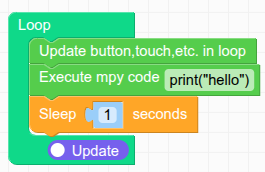Hello @ProfHuster
yes, that is what I observed too. As long as edit mode in Python code window is enabled, changes on the blockly side get ignored. (I guess that's to prevent changes from being overwritten.)
Thanks
Felix
Hello @ProfHuster
yes, that is what I observed too. As long as edit mode in Python code window is enabled, changes on the blockly side get ignored. (I guess that's to prevent changes from being overwritten.)
Thanks
Felix
Hello @ProfHuster
below is an example filled with print("hello"):

Please also have a look at my example in the UIFlow2 Project Zone called: M5Tab5_ExecuteMpyCodeTest_UIFlow2.3.9
Thanks
Felix
Hello @magister
in the mean time you could try and copy the correct Python statement into an Execute mpy code block. You can find it under System.
Thanks
Felix
Hello @ProfHuster
hmm, works for me with M5Tab5 UIFlow2 v2.3.9. It also got translated into Python code window.
Thanks
Felix
Hello @BruderTom
the issue seems to be an I2C conflict. Internal I2C already uses Wire1; the PPS code initializes a second I2C instance (Wire) with the same GPIOs for SDA and SCL. The result is: both I2C instances (Wire and Wire1) fight against each other.
Try replacing below line so the correct Wire1 instance is used for PPS as well:
// while (!pps.begin(&Wire, M5.In_I2C.getSDA(), M5.In_I2C.getSCL(), MODULE_POWER_ADDR, 1000000U));
while (!pps.begin((M5.In_I2C.getPort() == I2C_NUM_1) ? &Wire1 : &Wire, M5.In_I2C.getSDA(), M5.In_I2C.getSCL(), MODULE_POWER_ADDR, 1000000U));
Thanks
Felix
Hello @BR123456
it looks like the internal scan in UIFlow 2.3.8 default scanner is broken - I do not get any results either.
However if I scan the internal bus via I2C blocks it picks up all internal I2C addresses and what's connected to the M-Bus. The example is called M5Tab5_I2C_Scan_Test_UIFlow2.3.8 and you can find it in the UIFlow2 Project Zone.
Thanks
Felix
Hello @paulgrevink
have you tried to disconnect everything from M5StickCPlus2 and fully powering it off by pressing and holding the power button?
Also have you tried to erase flash using M5Burner before installing UIFlow2 firmware?
BTW: I did a test and installed ESPHome basic firmware, then installed UIFlow2.3.8 firmware and then ran M5StickCPlus2_GPIO32_GPIO33_ON_OFF_UiFlow2.2.0 from Project Zone without issue, e.g GPIO32 and GPIO33 toggle just fine between 0 V and 3.3 V.
Note: While ESPHome was installed GPIO32 measured something like 0.2 V.
Thanks
Felix
Hi guys
yes, it looks like there was a display / touch related change. See Screen Driver Change note here.
My guess would be that this change has not yet fully been integrated into UIFlow2.
Thanks
Felix
Hello @Rusticus42
there is a solution: use a M5PbHub unit (which is an I2C unit) to read the button states of the Dual Button unit.
I created an example in the UIFlow2 Project Zone: M5AtomS3_RFID_PbHub_DualButton_Test_UIFlow2.3.7
Note: I do not have an M5AtomS3R so you probably need to adapt the example.
Thanks
Felix
Hello @Rusticus42
yes, it is possible to connect more than one I2C unit. However Dual Button unit is not an I2C unit. You can see that from the color of the connector.
The connector on AtomS3R is white which meas it can be setup for I2C, I/O or UART mode, but only one at the time.
Thanks
Felix
Hello @MCU1536
assuming you are using Arduino and the M5StamPLC library then it is clear as to why the date and time are not retained. There is no code in the M5StamPLC library to enable charging the RTC backup battery.
I created a PR which enables RTC backup battery charging.
Thanks
Felix
Hello @RPI25
hmm, I am afraid I am out of ideas, sorry.
Edit: BTW: I now tested with both, M5Core2 (original) and M5Core2 v1.1. RGB LED on port A work with both of them.
Thanks
Felix
Hello @RPI25
ok, three RGB LEDs should definitely not draw too much power.
When you add the RGB unit did you choose port A? By default port B is selected which uses different GPIOs.
Also, just to make sure, you did connect the input side of the RGB unit to M5Core2 port A, yes.
Thanks
Felix
Hello @RPI25
how many RGB LEDs are connected to port A? The flicker could indicate that port A is overloaded if too many RGB LEDs are attached.
Also, how do you power your M5Core2? Via USB-C or battery or other?
BTW: My test was with 6 RGB LEDs.
Thanks
Felix
Hello @RPI25
hmm, I've tested M5Core2 v1.1 and RGB with firmware v2.3.7 in UIFlow 2.3.7 and it works for me. No power issue at all.
You can find my example in the UIFlow2 Project Zone: M5Core2_RGB_Test_UIFlow2.3.7
Thanks
Felix
Hello @Physalice
this is strange indeed. Unfortunately I have no idea why this only happens when using M5NanoC6, sorry.
Thanks
Felix
Hello @Physalice
hmm, works for me. Make sure you are logged into your account before attempting to save your work into the cloud.
I created a small test - you could try to see if that loads the blocks for you. You can find it in the Project Zone called: M5NanoC6_RGB_LED_Blink_Test_UIFlow2.3.7
Thanks
Felix
Hello @Bat21
hmm, not completely sure what the issue is. I am running your example code in UIFlow2 v2.3.7 and when I press BtnA it cycles through Frwd, Rvrs and Stop just fine.
An attached battery seems to show the correct battery state as well.
Could you please cut down your example to the minimum showing the issue you are describing?
Thanks
Felix
Hello @clarksn
hmm, this sounds a lot like a polarity issue with the battery cables. Unfortunately there is no standard for this particular battery connector about which pin to be plus and minus. I've seen both variants in the wild.
My M5Tough, powered via internal battery connector, takes about 68 mA @ 4 V when running UIFlow2.
Thanks
Felix